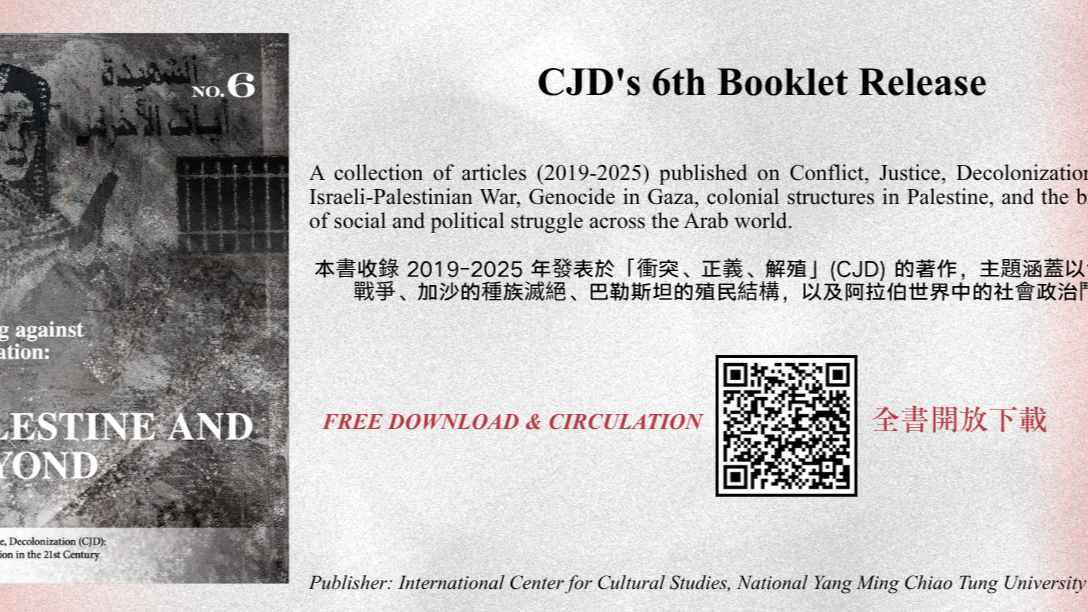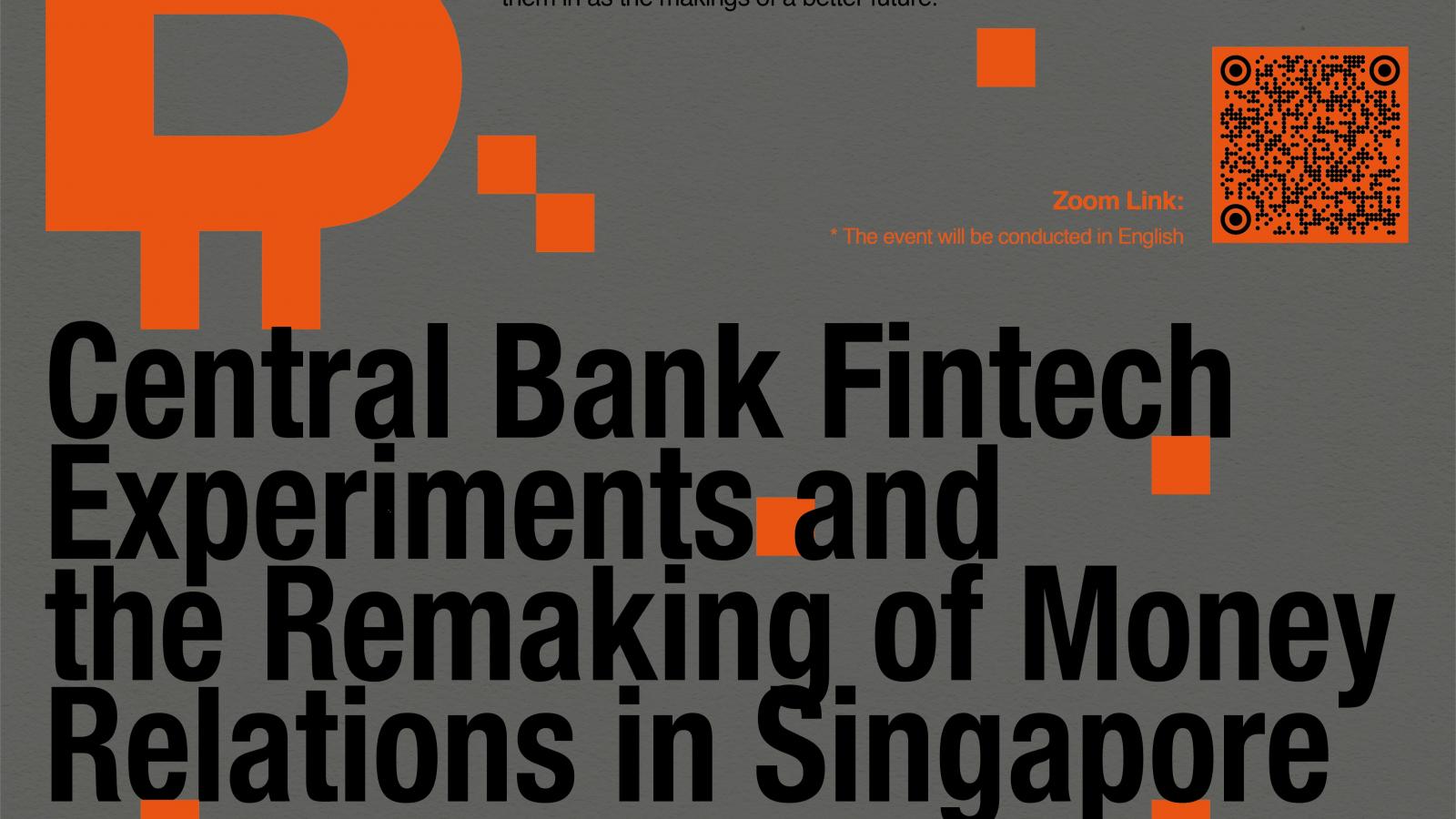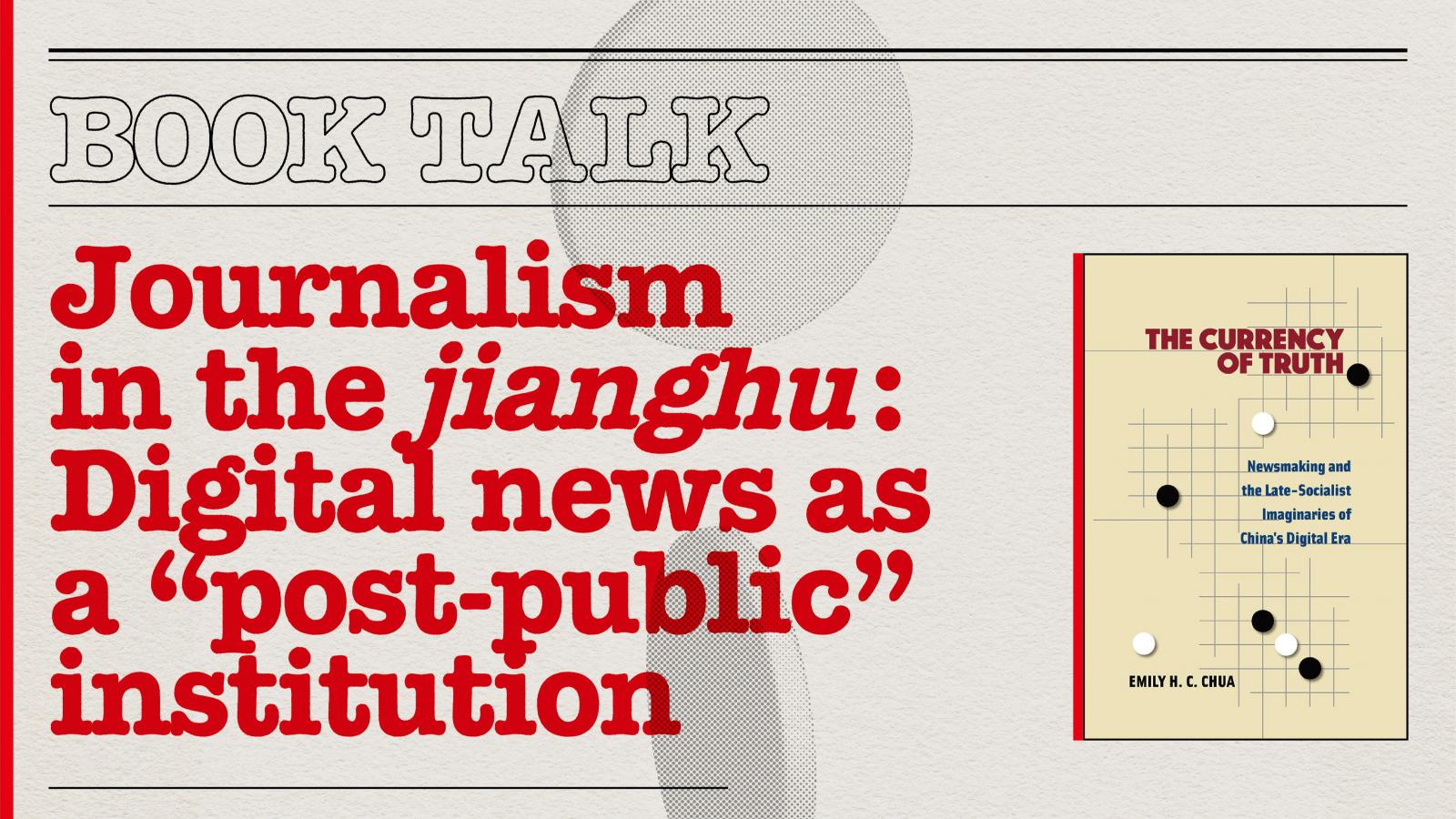

側記|Central bank fintech experiments and the remaking of money relations in Singapore
2025-10-22
Date and Time: 2025/10/2214:00-16:00 (GMT +8)
Venue: R106A, HA Building 2, Guangfu Campus, NYCU
Format: Hybrid (online & in-person)
Speaker: Emily H. C. Chua (Department of Sociology and Anthropology, National University of Singapore)
Discussant: Jacob Hjortsberg (Department of Business Humanities and Law, Copenhagen Business School)
Moderator: Allen Chun ( International Center for Cultural Studies, NYCU)
Event Info | LINK
Event Photo | LINK
Reported by|Serena Di Maria (Institute of Social Research and Cultural Studies, NYCU)
Sub-project|Subproject I: The Geopolitics and Cultural Economy of Societal Relations in a New GreaterChina
Convener|Allen Chun
On October 22, 2025, the International Center for Cultural Studies at National Yang Ming Chiao Tung University (ICCS-NYCU) hosted Professor Emily Chua (Department of Sociology and Anthropology at the National University of Singapore) for a second lecture, following her earlier talk on her book The Currency of Truth (2023). This time, she presented her ongoing research on the topic “Central Bank Fintech Experiments and the Remaking of Money Relations in Singapore.” The event was organized and moderated by Professor Allen Chun (ICCS-NYCU).
The project, still in its early stages, explores how the Singapore government’s promotion of fintech development is transforming everyday life in the island-nation, potentially redefining what constitutes a nation and what it means to be a citizen. The central question guiding Chua’s research is: “How does fintech, as an instrument of the nation-state, alter the nation-state itself?” Her emerging hypothesis suggests a conceptual shift from “national currencies” to “fintech monies”, through which the citizens’ relation to value and money is being reconfigured.
Chua began by presenting empirical data from her ongoing fieldwork on two initiatives developed by Singapore’s central bank, the Monetary Authority of Singapore (MAS): “Project Ubin” and the annual “Singapore Fintech Festival.”
The central bank of Singapore operates under the authority of the Prime Minister’s Office, with the Chairman of the MAS Board always being a senior government official. The MAS functions not only as a financial regulator but also assumes a developmental role, ensuring that the financial services sector remains technologically advanced. This dual function helps explain the MAS’s strong commitment to promoting fintech experimental projects in Singapore.
Project Ubin consisted of a series of experiments conducted between 2016 and 2020 in collaboration with major corporate banks—both local and international—as well as other financial institutions such as the Singapore Exchange and Temasek, Singapore’s sovereign wealth fund. The initiative aimed to bring together diverse organizations to prototype primarily blockchain-based solutions for backend financial operations.
The project unfolded across five phases, each expanding in scope and in the number of collaborators involved. In Phase One, it developed a prototype for scheduling RTGSs (Real-Time Gross Settlement) on a blockchain. This innovation sought to automate interbank transfers processes, traditionally managed manually by the central bank, by making transactions cheaper, faster, and more secure.
By Phase Five, the project’s ambitions had grown to envision a blockchain-based payments platform enabling banks and businesses worldwide to transact directly with one another. At present, such transactions rely on a correspondent banking system (the SWIFT network), whereby funds make several intermediary stops before reaching their final destination. This system is costly, slow, and risk-prone at every stage. In contrast, a blockchain-based infrastructure could make transnational payments cheaper and more efficient, though achieving universal trust and adoption among global banks remains a significant challenge.
The Singapore Fintech Festival has been organized by the MAS since 2016 and has grown year by year into a major global event, reflecting Singapore’s emergence as a leading hub for technological financial innovation. The thematic packaging of the event presents fintech as invested in addressing universal human concerns such as the future of humanity, the financial gap, inequality, inclusion and environmental sustainability, showing its large scope of ambition.
Chua’s analysis of these projects aims to move beyond the familiar narrative that stresses the expansion of capitalism through a technologically advanced financialization nurtured within an authoritarian one-party-dominated context like Singapore, coupling obscure technical efficiencies with bizarre emotional investments. Whilst acknowledging some truth to this explanation, Chua is more interested in exploring the deeper transformations in everyday life that arise when technologies are applied directly to money itself. Such innovations, she argues, are reshaping how money operates and, in turn, how people live with and think through it, altering fundamental experiences and conceptions of value, relationality, time, and selfhood.
Her research situates these transformations at the intersection of fintech and the nation-state. Fintech is the application of constantly evolving technologies to the financial sector, which are reshaping the way money moves, gains and loses value. In Singapore, the central bank has sought to harness fintech to develop advanced systems of money circulation while keeping financial activities within state-regulated boundaries. Chua remarked that, in this context, fintech functions as a state-driven instrument of national economic strategy, unlike in the U.S. or South Korea, where it usually compensates for a retreating welfare state and signals a withdrawal of the state from financial governance.
This development reflects Singapore’s broader state-led economic model, established under the People’s Action Party since independence in 1965. Particularly, in the absence of natural resources, the Singapore model relies on treating citizens as the key resource for economic growth. From industrial education in the 1970s to the knowledge economy of the 1990s, and now to fintech innovation, the government has continually re-engineered its population to drive economic and financial development. In this new phase, citizens are enrolled into experiments that remake money itself, altering not only economic practices but also lived experiences of value, time, and relationality.
The central argument Chua is currently advancing suggests that the government-led developing of fintech solutions in Singapore might be producing a shift from cultures that were centered in money as national currency to others organized around what she calls “fintech monies”.
National currency refers to a form of money that became dominant in the nineteenth century, following the consolidation of the nation-state as the primary political and economic entity. Drawing on scholarship that examines how the imagined nation becomes inscribed in the materiality of national currency, Chua observes that, in Singapore, the national currency gestures toward the imaginary of a small, self-reliant nation, embodying the ethos of a community of disciplined, self-sacrificing and hard-working people who take pride in enjoying the fruits of their labor materialized in a stable currency that ensures material comfort and economic security.
In contrast, fintech monies are talked about from a technical-first perspective. In this discourse, money is conceived as a site of innovation and defined by attributes such as speed, security, cost-efficiency, accessibility, traceability, and interoperability—qualities valued for their technological rather than ideological significance. Within venues like the Fintech Festival, these technical features are understood, in turn, as monetizable. For example, money can be generated by making money move faster.
As for how these changes affect people’s lives, Chua suggests that although most citizens are not fully aware of the details of these projects, they are broadly conscious of the government’s endorsement of fintech instruments as new avenues for generating profit from financial activity. This has led to a normalization of evolving financial technologies, accompanied by a growing pressure to adopt new fintech services. Those seeking to secure a place in the future feel compelled to keep pace with these tools, even as they struggle to understand their opaque mechanisms. These technologies are technically complex, their terms of use often unclear, and their implications difficult to grasp. Over time, people have become accustomed to the idea that each financial transaction involves far more than a simple exchange in national currency: it activates and sustains an entire network of actors and interests engaged in financial operations that most users remain only dimly aware of.
Another impact concerns the reframing of the problem of inequality: in venues such as the Fintech Festival, inequality is redefined as a problem of financial access rather than one of redistribution. Fintech discourse promotes the idea that applying technology to make money “work differently” can bridge social and economic gaps, benefiting both low-income users and high-volume, low-margin businesses. Chua notes that this logic normalizes the view of inequality as merely a technical problem, solvable not through redistribution of money in its current form, but through innovation in how money functions.
At the end of Chua’s presentation, the invited discussant, Jacob Hjortsberg (Department of Business Humanities and Law, Copenhagen Business School), offered a series of insightful observations and thought-provoking questions. He began by linking the discussion to his own framing of Singapore as a “middle-man minority state”, an argument developed in his PhD dissertation. This concept describes ethnic minority groups that, within a host society, outperform the ethnic majority economically while remaining culturally distinct. Hjortsberg argued that Singapore exemplifies this position at the level of the state: its combination of open, market-driven capitalism and an authoritarian political structure mirrors the classic middle-man minority dynamic—economically integrated yet culturally distinct, sustained by paternalistic and patriarchal social structures.
Hjortsberg further noted that while blockchain and cryptocurrency are typically associated with decentralization and state-free markets, the Singaporean government appears to be co-opting these technologies to reinforce centralized governance. He suggested that, in this context, the government (through the central bank) might be assuming a kind of middle-man role, mediating between financial technological innovation and the national project.
Chua agreed with Hjortsberg’s view that the MAS acts as a kind of middle-man, noting that the government views fintech primarily as a strategy for economic growth and national survival. Its interest lies in strengthening state-regulated financial order rather than embracing fintech’s more liberal, decentralized potential. Ultimately, the aim is to protect citizens from volatile cryptocurrencies while promoting these technologies to enhance the efficiency of financial operations without redistributing decision-making power.
Other points for reflection raised by Hjortsberg concerned the role of the CPF (Central Provident Fund) and the relation between currency and the nation-state, particularly the idea of having a national currency as a marker of sovereignty. While cryptocurrency and fintech technologies challenge the authority of national currencies, he questioned whether the nation-state is the right frame for Singapore, or whether it should instead be understood as a city-state. Unlike the nation-state, which often relies on an ethnic imagination of community, Singapore’s cohesion derives from commerce and trade as unifying forces within a multiethnic society. This alternative framing, he suggested, could illuminate Singapore’s position alongside other authoritarian capitalist city-hubs such as Dubai.
In the ensuing discussion, Allen Chun reflected on whether the use of fintech could be meaningfully compared across different national contexts such as China or Taiwan, and what specific institutional conditions make Singapore’s trajectory possible or prevent its replication elsewhere.
Chua responded that, in Singapore we are witnessing an increasing financialization of citizenship, having evolved from a model of citizenship centered on economic productivity to one that also produces financial subjects. On the one hand, through the Central Provident Fund (CPF), individuals are required to save and receive a guaranteed minimum return; on the other, they are also encouraged to invest in the stock market and take financial risks, as the CPF includes options for personal investment. The financialization of citizens is a trend occurring at a global level, implicating, in many contexts, the withdrawal of benefits and guarantees. Chua noted that globally, pension systems have shifted since the 1970s–80s from defined benefits to defined contributions. What one receives now depends on investment performance rather than state guarantees. Yet what makes Singapore exceptional is that financialization there occurs not through the retreat of the state but under its active direction. The fintech projects led by the MAS attempt to modernize finance while keeping citizens’ monetary activities within national control and away from unregulated cryptocurrencies.
As a final observation, Hjortsberg noted that Singapore’s political logic more closely resembles that of an international organization than a classical nation-state. Whereas nation-states traditionally claim to represent the will of the people, international or corporatist organizations operate through stakeholders who represent their own interests, replacing democracy with transparency. He suggested that Singapore’s social contract, akin to that of an organization managing its stakeholders, may explain why fintech integrates so well into its governance model.
Chua, however, emphasized that Singaporean citizens cannot be reduced to mere stakeholders of the state. While governance certainly carries a transactional dimension, the state also invests heavily in cultivating an organic sense of unity that extends beyond economic participation, delivering on the promises of modern nation-states more effectively than in many other contexts.
近期新聞 Recent News

New Publication | Writing against Occupation: Palestine and Beyond (CJD Booklet No.6)
2025-11-12
more
側記|Central bank fintech experiments and the remaking of money relations in Singapore
2025-10-22
more